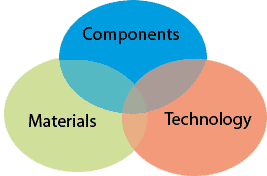Related Research
The Department of Microelectronics which offers the international MSc programme in Microelectronics, is one of the seven Departments within the Faculty of Electrical Engineering, Mathematics and Computer Science (EEMCS) of Delft University of Technology (TU Delft).
Five research Laboratories (also called groups, units or sections) participate in the research and teaching activities of the Department of Microelectronics and the Delft Institute for Microsystems and Nanoelectronics (DIMES).
DIMES integrates the research activities within Delft University of Technology dedicated to nanoscale and high-speed device physics, material science and process technology, circuit design, and embedded system design methodology in one institute and offers extensive fabrication and test capabilities. Consequently, most of the research activities of the 5 research laboratories of the Department of Microelectronics are part of the DIMES research programme.
Microelectronics Research Laboratories
- Electronic Components, Technology and Materials (ECTM)
- Electronic Instrumentation (EI)
- Electronics (ELCA)
- Circuits and Systems (CAS)
Electronic Components, Technology and Materials (ECTM)

The research of the Laboratory of ECTM is focused on microwave techniques, device physics, silicon technology and the characterization of electrical and material properties. This combination of disciplines is applied to the socially relevant areas of high-frequency circuits and devices, integrated sensor technology, solar cells and large-area electronics. Since ECTM has strong links with the DIMES technology center, creative ideas do not remain mere concepts, but are actually realized in practice and verified in a most advanced silicon processing line and high-frequency characterization laboratory.
Website ECTM
Electronic Instrumentation (EI)

The research mission of the Electronic Instrumentation Laboratory is to realize smart sensor systems for the acquisition of data from physical, chemical and biomedical signals. After mechanization and informatisation, sensorisation has become the largest obstacle to total automation. Therefore, breakthroughs are required in the technology, price, size, weight, power consumption and user-friendliness of sensors. To accomplish this goal, the Laboratory has chosen to pursue two goals. Firstly to realize sensors in an IC-compatible silicon technology suited for mass production. Secondly, to combine these silicon sensors with smart interface electronics, preferably in one package, to enable easy communication with the sensors.
Website EI
Electronics (ELCA)

The research of the Electronics Research Laboratory is concentrated on the leading edge of its field and in particular on issues relating to high-performance electronics design. In particular it is aimed at:
Understanding the limits and pushing forward circuit and system performance in terms of power consumption, operating frequency and non-linear behaviour.
Contributing to the development of new applications for communications, biomedical electronics and intelligent systems.
The group is actively investigating the design of electronic circuits with unique or exceptional capabilities. This often requires specialized devices that are not widely available or characterized, such as nanoscale devices and circuits, and on-chip magnetic components for RF applications.
Website ELCA
Circuits and Systems (CAS or N&S)

Research at the laboratory for Circuits and Systems centers around design methodologies for circuits and systems, at different levels of abstraction. Current efforts include:
Signal processing algorithms In particular sensor array signal processing ("smart antennas"), with emphasis on the underlying structured matrix computations.
Signal processing architectures For the execution of such algorithms. These typically center around the (pipelined) CORDIC processor.
System theory, In particular of time-varying and nonlinear systems.
Development of a framework of CAD tools For VLSI circuit design, including VHDL synthesis, layout synthesis, and design verification.
Circuit component modeling and layout extraction, With emphasis on the parasitic effects.
Website CAS